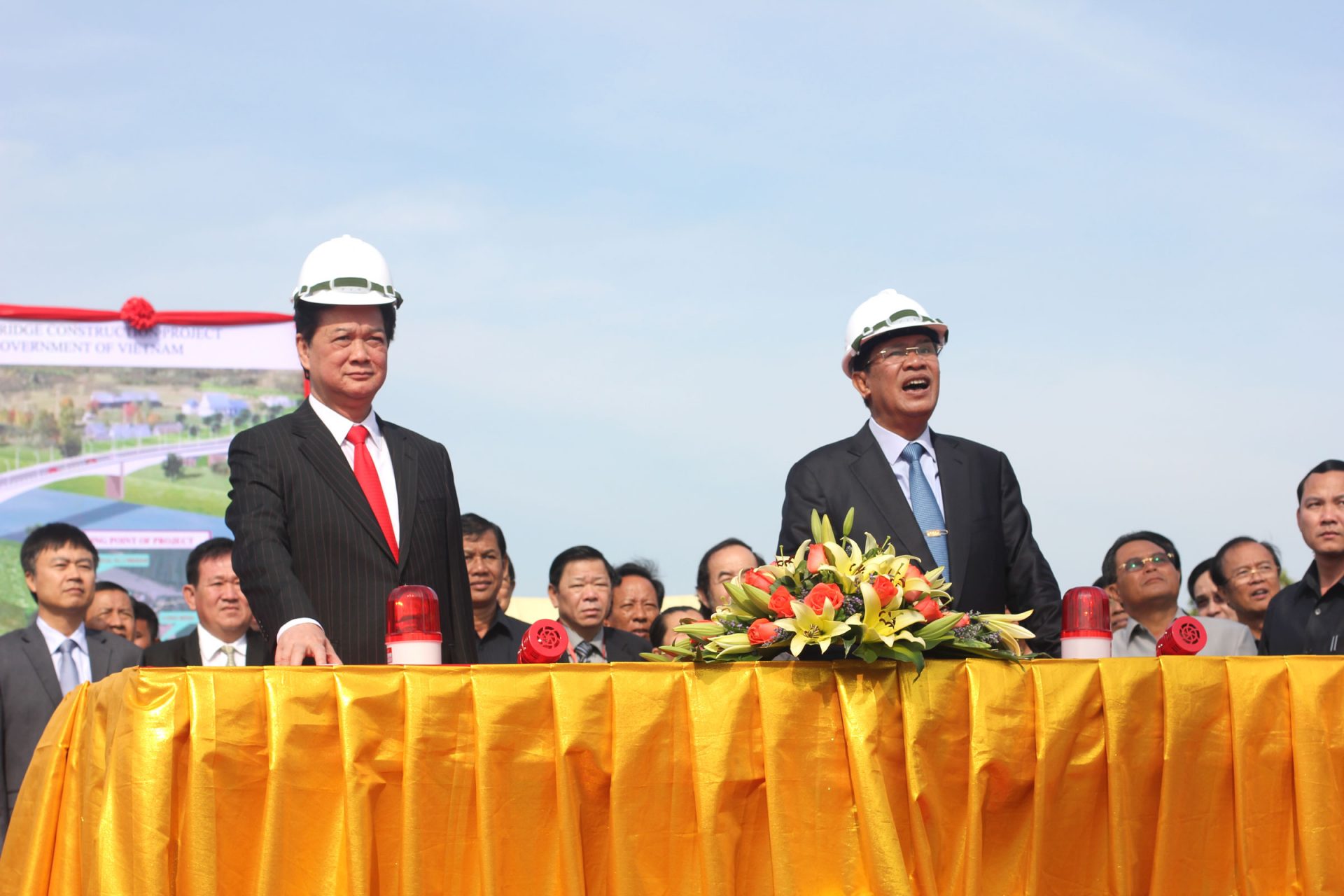KOH THOM DISTRICT, Kandal Province – Prime Minister Hun Sen used a groundbreaking ceremony for a new bridge linking Cambodia to Vietnam on Tuesday to reiterate that he has no plans to step down from his position, and told opposition supporters who have called for his ouster to settle in for a long wait.
The ceremony for the $38.4 million Chrey Thom bridge in Kandal province’s Koh Thom district, which was agreed on during Mr. Hun Sen’s trip to Vietnam last month, came on the third day of a three-day visit by Vietnamese Prime Minister Nguyen Tan Dung.

Arriving in separate helicopters at about 8 a.m., the prime ministers embraced each other before touring a crowd of cheering supporters on their way to a stage set up near the new bridge site.
After a brief speech by Mr. Tan Dung, which was translated into Khmer, Mr. Hun Sen recalled the storied history of conflict between Vietnam and Cambodia, contrasting the massacres and border raids of the Lon Nol and Khmer Rouge regimes of the 1970s with the close relations his government has since maintained with the Vietnamese.
“This bridge can be characterized as a vital friendship bridge,” said Mr. Hun Sen, who was installed as prime minister by the Vietnamese in 1985. “If the two countries were embroiled in conflict, this couldn’t be located here today, and it would mean there would be plenty of weapons deployed here.”
“This link will fulfill each other’s needs, and will leave neither the loser,” he explained. “Don’t roll in weapons, clicking buttons to bombard from this and that side. Let’s bombard here with electricity and bombard with goods and then we will bombard goods from here to there.”
With little of the belligerent words or body language that characterized many of his speeches before last year’s disputed national election, Mr. Hun Sen appeared relaxed and jovial through his speech, at one point even making light of the tens of thousands of people who have marched through Phnom Penh chanting for him to “get out.”
“What’s all this about ‘Choh Chenh Tov Euy’?” Mr. Hun Sen asked flippantly, drawing laughs from both the Vietnamese prime minister and the audience. “Please just wait. There is no way. I have been elected following the Constitution…. There is nothing more to say.”
Mr. Hun Sen did, however, make an apparent jibe at opposition CNRP leaders Sam Rainsy and Kem Sokha, who late last year led tens of thousands of striking garments factory workers on marches through Phnom Penh to demand a higher minimum wage.
“Some people demand $160, but they only offer their own drivers $60,” the prime minister said, before outright dismissing the $160 demand.
“Someone posted this comment on Facebook: If the children cry out for more rice, the father should beat them—but the father doesn’t beat them, and only tells the child: ‘You can have one more ladle. As our family is poor, wait until we become a bit more rich and then father will feed you fully,’” the prime minister said, in obvious reference to pay demands in several sectors.
A week after garment factory workers called a nationwide strike last month in reaction to the decision to increase their minimum wage from $80 to $95, the government on December 31 announced a decision to further increase the basic wage to $100.
Three days later, military police armed with AK-47s rampaged through a protest on the garment factory-lined Veng Sreng Street against the small increase in the wage, shooting dead five striking garment factory workers and wounding more than 40.
In his speech, Mr. Tan Dung said that Vietnam was funding half of the $38.4 million for the bridge—which crosses the Bassac River about two hours south of Phnom Penh—and loaning the other half to Cambodia through a low-interest “official development assistance” (ODA) loan.
“Even though Vietnam is still a poor country, Vietnam will continue offering ODA and other types of financing to develop projects for the spirit of our good neighboring countries and for mutual understanding,” Mr. Tan Dung said, also praising the new bridge.
“This will create a very short way to travel to Phnom Penh and to the Ang Giang provincial gate,” Mr. Tan Dung explained.
After their speeches, the two prime ministers made their way to a table set up on the banks of the river. Placing hardhats on their heads, Mr. Dung pressed a red button that plunged a concrete pillar into the ground, officially beginning the construction of the 428-meter-long bridge.
Public Works and Transport Minister Tram Iv Tek said that the bridge will be built by the Cambodian-owned Sok Sokha Co. Ltd. and Vietnamese-owned CIENCO1 (Civil Engineering Construction Corporation No. 1) and will be completed in 30 months.




